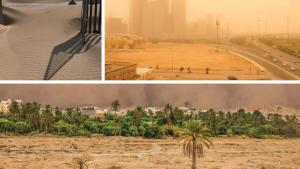Sand and Dust Storms in the Middle East and North Africa (MENA) Region: Sources, Costs, and Solutions
Dust storms are capable of transporting sediment over thousands of kilometers, but due to the Middle East and North Africa (MENA) region’s proximity to the Sahara Desert, the region is one of the dustiest in the world. While natural sources such as the Sahara are the main contributors to dust storms in MENA, land-use changes and human-induced climate change has added anthropogenic sources as well.

Like sources, drivers of sand and dust storms are also natural and anthropogenic, as both wind speed and land management can cause them. Dust deposition has wide-ranging health impacts, such as causing and aggravating asthma, bronchitis, respiratory diseases, and infections and lung cancer. Apart from devastating health impacts, dust also impacts the environment, agriculture, transport, and infrastructure. Globally, welfare losses from dust are approximately 3.6 trillion USD, where costs are about 150 billion USD and over 2.5 percent of Gross Domestic Product (GDP) on average in MENA.
Besides investing in early warning systems, governments all over the world are designing policies to mitigate the impact of sand and dust storms, both at national and regional levels. The World Meteorological Organization (WMO) launched a sand and dust storm warning system that aims to deliver reliable dust storm forecasts through a network of research organizations all over the world. It aims to improve the ability of countries to deliver quick and high-quality sand and dust storm forecasts and knowledge to users through an international partnership of research and operational organizations.
Source: World Bank
- 313 reads
Human Rights
Ringing FOWPAL’s Peace Bell for the World:Nobel Peace Prize Laureates’ Visions and Actions

Protecting the World’s Cultural Diversity for a Sustainable Future

The Peace Bell Resonates at the 27th Eurasian Economic Summit

Declaration of World Day of the Power of Hope Endorsed by People in 158 Nations

Puppet Show I International Friendship Day 2020

